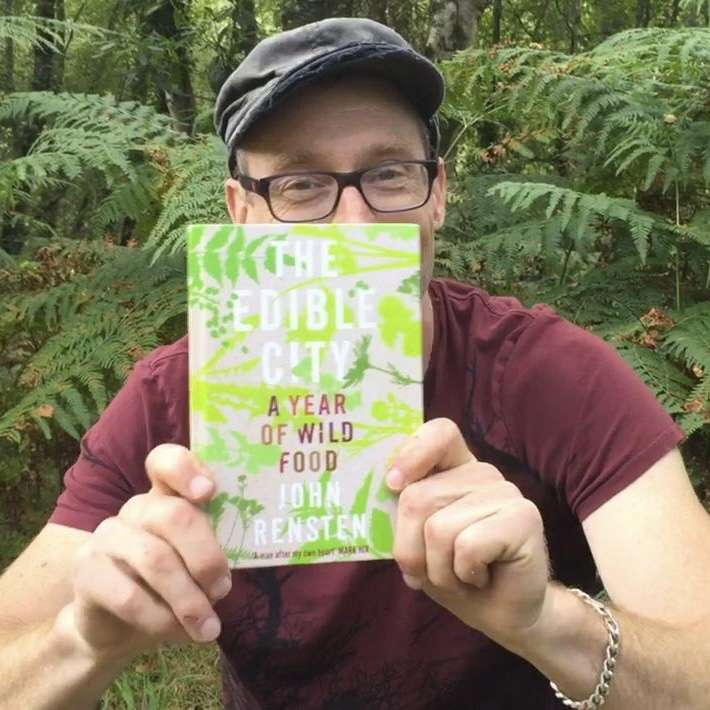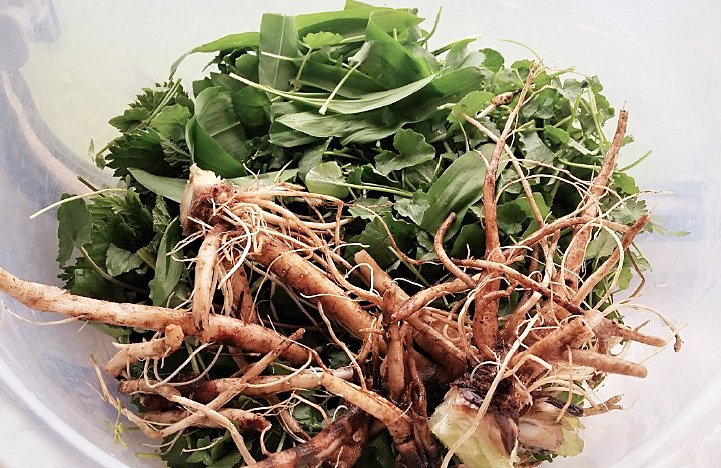
Richard Mawby is a forager and a modern hunter gatherer. He has re-wilded his gut over a number of years and attains most of his nutrition from wild seasonal food alongside traceable food staples that closely mimic a true late-paleo diet.
“With the not-so-harsh winter on its way out, wild spring greens start making their debut, earlier in London than most parts of the country due to the warmer city environment. We have all heard of people using nettles and dandelions as food and those reading this blog have probably tried them themselves, but have you experienced any of these lesser used but abundant, edible, wild plants?
CLEAVERS.
This is one of my favourite plants to see when spring arrives (especially with this strange shift in seasons that has resulted in a milder winter). Sticky Grass, Goose Grass or Sticky Willy to give it a couple more of it’s popular names, grows everywhere – literally! You can find it on waste grounds, allotments, in woodlands and I tend to find it more in disturbed places, often growing with its nitrogen loving friend, the stinging nettle. If you find nettles, you will more than likely have sticky grass in your midst. Galium aparine (it’s Latin name), is a distinctive plant in the bedstraw family which also includes Hedge Bedstraw, Lady’s Bedstraw, Sweet Woodruff and even coffee, each with their own unique qualities. With all these nicknames, it is evident that Cleavers has played a big part in our history and our knowledge of wild edibles; often found in abundance close to early neolithic settlements, it is possible that this is one our first ‘cultivated’ food crops. You can easily identify this plant by its six to eight simple leaves that grow in whorls (wheels) at almost equal intervals around the stem. The most obvious feature combined with its distinct appearance is the fine, hooked hairs on both the stem and the leaves. You have probably thrown this at your friend’s back to see how long it takes for them to notice.
Other members of this plant family are perfectly edible too, so there’s very little risk in mis-identifying it and potting the main difference between sticky grass and its relatives is easy. Its fine hairs stick to everything and you can feel this abrasive texture when you rub your fingers along the leaves (Hedge Bedstraw – its closest look alike will feel very soft by comparison). This wild herb really shines for its health benefits, flushing out the lymphatic system and with detoxifying properties that can also help with various skin conditions. Personally, I love to make refreshing juices by simply blending handfuls of this plant with filtered or bottled water and straining through a fine cloth, muslin or nut milk bag filter to produce a clean light green refreshing liquid that is always a delight to consume. If you are not keen on the flavour, why not try adding it to your morning smoothie, or stir a little honey and ginger into the juice.
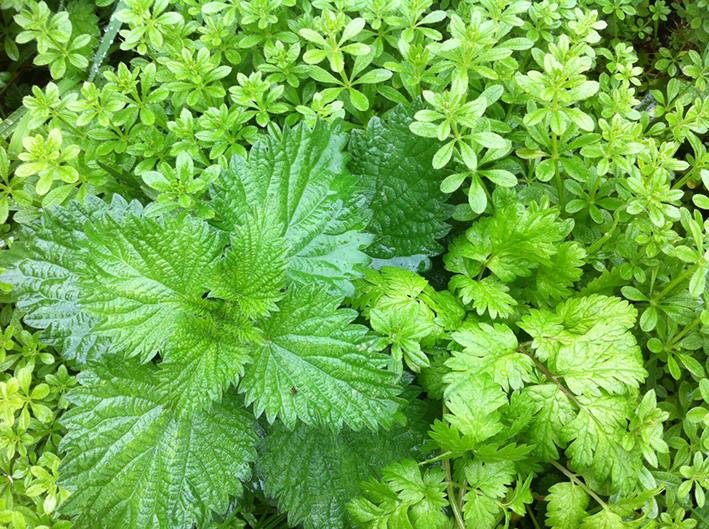
HERB ROBERT.
Herb Robert is a source of germanium, a trace mineral, anti-oxidant and valuable element for the body, with the ability to make more oxygen available to the cells. More oxygen, at cell level, means the body has the opportunity to fight disease by its own powers. Herb Robert also contains Vitamins A, B and C, potassium, phosphorous, calcium and manganese. Accompanied with cleavers nettles and dandelions, I often make morning juices that wake me up from the cold winter slumber and prepare my body for what spring has to offer. People say you can confuse this plant with bleeding heart and poison hemlock, but I personally see no real similarity especially when you factor in its flowers and ‘crane’s bill’ shaped seed pods. Herb Robert’s scent alone can separate it from the plants above and if you look carefully its leaves are distinctly different from any potential lookalikes. This herb loves partially shaded areas and its natural home is in moist woodland but it is very adaptable and you can find it growing almost anywhere. I can guarantee it will be in and around any London park or garden and once you find it you will be surprised by how common it is. I have also used this plant in teas and dishes that require that deep earthy grounding flavour unique to Herb Robert. If you feel that the flavour of this particular herb overpowers your senses, I urge you to revisit it another day as you wander deeper into your wild food journey. The further I re-wild my taste buds the more I find myself appreciating this wonderful plant.
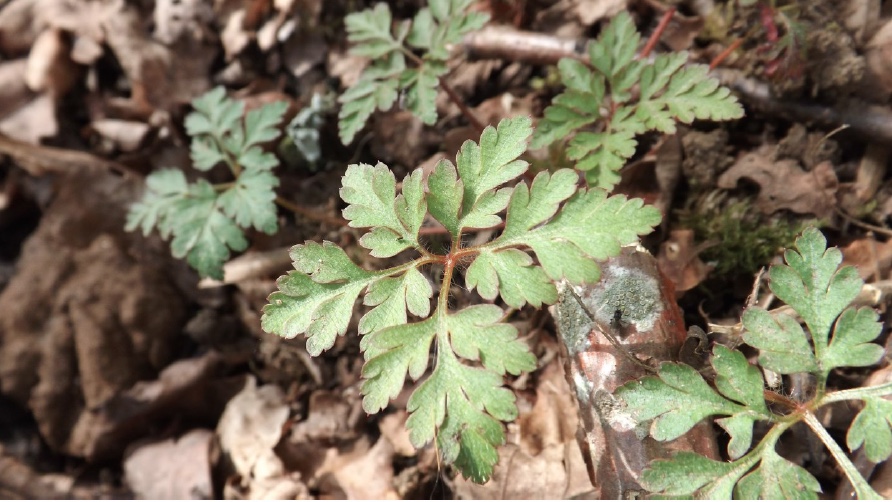
LESSER CELANDINE.
This wonderfully abundant creeping plant is somewhat unusual in the buttercup family. Unlike many of its relatives Ficaria verna (its latin name) has minimal quantities of Protoanemonin, an active toxin, large doses of which can cause nausea and other adverse reactions. Warnings aside, the amount of this toxin in Lesser Celandine is minimal and not harmful to a healthy individual. In my experience, you would have to eat huge quantities of this plant for it to be deadly, but I would also avoid it when it flowers as toxicity is said to increase. I personally have not had any problems with this plant. But any risk can be reduced or eliminated by boiling the leaves and straining the fluid if you want to be extra safe. The reason I love this plant is that it is one of the first greens to appear in the year. It can show its face as early as January and makes a wonderful bulking leaf for spring salads where other flavours like wild garlic and bittercress might be overpowering in larger quantities. It prefers damp places and you will commonly find it in shaded woodlands close to streams or wet ground. You might also find it in meadows, waste ground, road sides, river banks, gardens and allotments especially where the land is seasonally flooded. In prime conditions you will find carpets of lesser celandine covering vast spaces that make a woodland floor look magical when its yellow flowers begin to emerge. With individually stalked cordate (heart shaped) veined leaves and roots with bulbils (multiple bulb-like structures) ensure that you can safely identify this plant. Certain plants have historically been attributed medical uses based on their appearances hence the old english name for this ‘pilewort’. I have often noticed that once Lesser Celandine has appeared, wild garlic is not far off and I have found these two plants growing side by side on many occasions – including the not so favoured Lords and Ladies which you should avoid for its adverse reaction if ingested. However, witnessing the sprouting of Lords and Ladies brings a smile to my face, as Wild Garlic especially in my patch, is soon to follow.
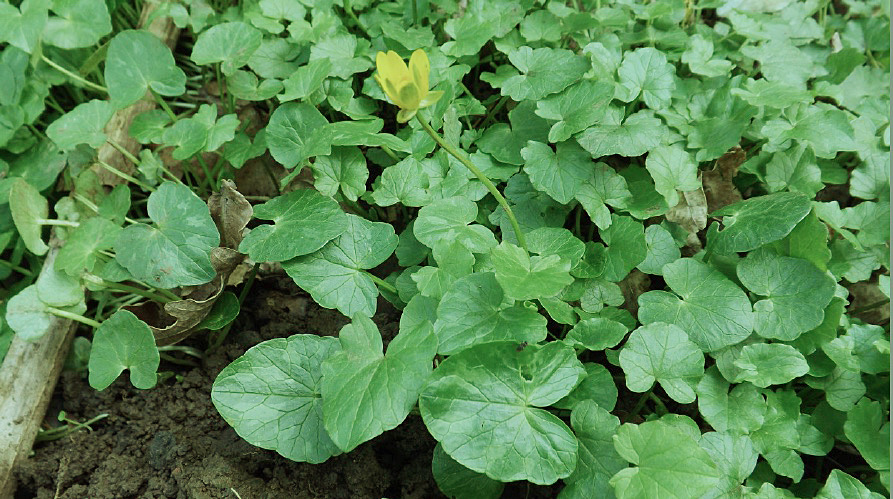
THISTLES.
Fun Fact: Did you know that the globe artichoke is a cultivated thistle?Related to dandelions, thistles are in the Asteraceae family but these prickly plants are often overlooked and perceived as the ‘gardener’s bane’. It’s hard to misidentify these plants and there are various species within this genus. Some have milky sap whilst others have thicker and pricklier stems. For the purpose of this article we will look at the ‘common Thistles’ which includes Field Thistle and other similar varieties, but they do not have milky white sap. The milky sap usually means you have a Sow Thistle or similar and these tend to share properties and flavours to wild lettuce and the milder Dandelion. For the novice forager, white milky sap is to be avoided on any unknown plants. For the purpose of this article we will look at the common thistle (Cirsium vulgare) which is otherwise known as a spear thistle or bull thistle and does not have milky white sap. The only other thistle that you might confuse with the common thistle is the Marsh Thistle (Cirsium palustre) which is a part of the same species and is also edible and just as rewarding. Sometimes I find that Marsh Thistle provides a thicker and juicier stem – and unlike the common thistle, it usually has many more spikes on the stem itself protecting the soft delicious centre.
The common thistle needs no introduction. It’s prickly mess of leaves and stem makes it quite difficult to handle this plant but where there is a will there is a way. At their prime growth, before they flower and become too hard and fibrous, I love to strip the leaves and the stem of its spikes with a simple knife that I carry with me whilst on my forays. This reveals a tender, moist and crunchy stem that is not too dissimilar to a cross between cucumber and celery. Despite their stems and prickly leaves I have also blended thistles in filtered water and then strained through a nut milk bag filter (for its super fine nylon mesh) to remove any sharp and fibrous material. This produces a dark green juice that is rich with many minerals and vitamins that the thistle is able to pull up from deep below the soil due to its impressive tap roots.
Thistles are biennial meaning that they form a basal rosette in the first year before bolting and flowering in the second. If you catch these just before they are about to bolt you can harvest some sizeable tubers. Any later and they turn woody and fibrous. The tubers combined with nettle tops and a few other wild ingredients create the most delicious and hearty soup that uses the wild plants introduced in this article and more, recipe to follow. Please note: that whilst nobody will probably mind you digging up their thistle roots, it is against the law to uproot any wild plants without the land owner’s consent. Unless you are harvesting from your own garden or allotment, please seek permission before uprooting any wild edibles.
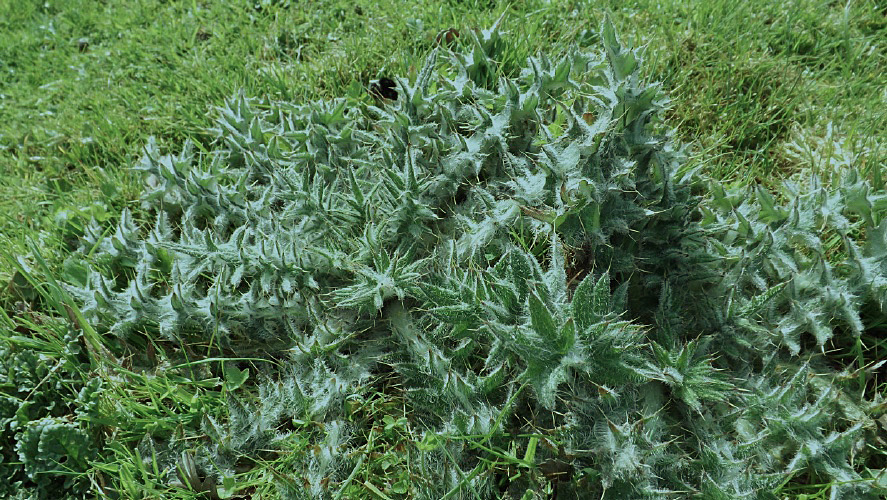
THE FUN PART: RECPIPE FOR A HEARTY WILD THISTLE-ROOT SOUP
Please bear in mind that these are estimations as I never measure what I create. Play around with the below ingredients to create your own unique and delicious meal…
Thistle Root = Dig up 4-5 good sized roots.
Nettle tops = A handful or two.
Lesser celandines = A handful or three.
Wild garlic = A handful or three.
Herb Robert = Half a handful.
Cleavers = A handful.
Butter = 125g – 150g approximately.
Milk = 500ml – 750ml approximately.
Seasonings: Salt, Pepper, Powdered seaweed (optional).
THE METHOD:
Wash and cut up the thistle root into small segments and then boil and simmer in a shallow pan of water with a little butter and maybe a touch of salt and pepper until the root softens. It might still be kind of firm and not very soft like other tubers. Make sure that it has cooked thoroughly before you move onto the next step. Add everything but the wild garlic to a larger soup-sized pan and boil then simmer until everything has wilted but not overcooked. Stir in the wild garlic and any extra butter, salt and pepper to taste. Grind the ingredients together with a hand held blender until the soup is smooth and thickened.
Serve warm with a boiled egg or two and if you have powdered seaweed at hand, sprinkle a little over the soup and enjoy.
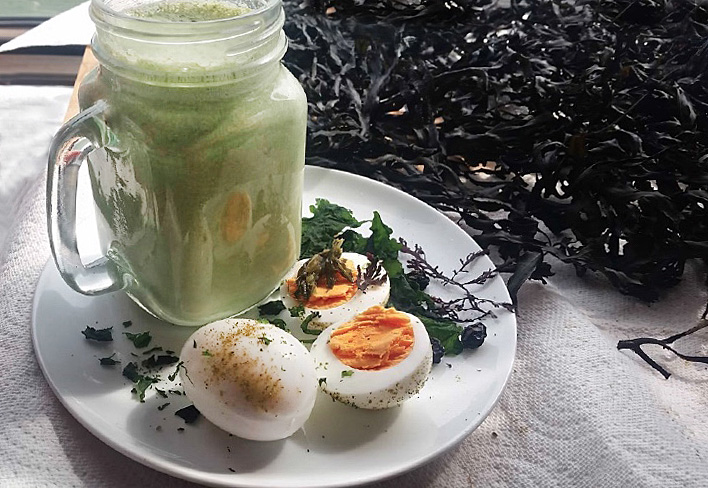
Richard Mawby is a forager and a modern hunter gatherer. He has re-wilded his gut over a number of years and attains most of his nutrition from wild seasonal food alongside traceable food staples that closely mimic a true late-paleo diet.
He enjoys the outdoors, travelling, writing, inspiring, and being the change he wishes to see in the world whether it be through foraging courses, random encounters or eccentric journeys around the country on contraptions built from re-purposed junk and DIY stores (see his website for videos on the solar-powered tricycle). In 2019 he hopes to be diesel and petrol free by building a long ranged DIY electric car using a G-wiz.
Join him on his adventures through the website link below:
